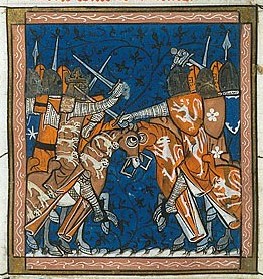List of English civil wars
Appearance
This article needs additional citations for verification. (October 2024) |
This article provides a list of internal military conflicts throughout the history of England.
Civil wars
[edit]
This is a list of civil wars that have occurred in the history of England.
- The Anarchy (1135–1154) – a civil war in England and Normandy between 1135 and 1154 surrounding a succession crisis towards the end of the reign of Henry I, fought between the supporters of the claim of King Stephen and that of Empress Matilda (also known as Empress Maud or Maude). The eventual outcome was the accession of the Angevins in the person of Henry II.
- First Barons' War (1215–1217) – a civil war in the Kingdom of England in which a group of rebellious barons, led by Robert Fitzwalter and supported by a French army under the future Louis VIII of France, made war on King John of England.
- Second Barons' War (1264–1267) – a civil war between the forces of a number of barons led by Simon de Montfort against Royalist forces led by Prince Edward (later Edward I of England), in the name of Henry III.
- Despenser War (1321–1322, 1326) – a baronial revolt in England and Wales against Edward II instigated by Marcher Lords in opposition to court favourite Hugh Despenser.
- Invasion of England (1326) – Continuation of the Despenser War. Isabella of France, and her lover, Roger Mortimers invasion led to: the executions of Hugh Despenser the Younger and Hugh Despenser the Elder; The abdication of Isabella's husband King Edward II for their son Edward III; and Edward II died, most likely assassinated by orders of Isabella and Mortimer.
- Wars of the Roses (1455–1487) – a series of dynastic civil wars for the throne of England fought between supporters of two rival branches of the royal House of Plantagenet: the House of York and the House of Lancaster.
- The English Civil War (1642–1652) – a series of armed conflicts and political machinations between Parliamentarians ("Roundheads") and Royalists ("Cavaliers") in the Kingdom of England over, principally, the manner of its government.
- First English Civil War (1642–46) – the supporters of King Charles I against the supporters of the Long Parliament
- Second English Civil War (1648–49) – the supporters of King Charles I against the supporters of the Long Parliament
- Third English Civil War (1650–52) – the supporters of King Charles II against the supporters of the Rump Parliament
- Jacobite Rebellions –A Civil war in England, Scotland, and Ireland fought over many years to restore the House of Stuart to the British throne. The conflict started after James II and VII was deposed and exiled in the Glorious Revolution of 1688.
- Williamite War in Ireland (1688–91) –The Battle of the Boyne saw the last battle between two rival claimants for the throne
- Jacobite rising of 1689 (1689–92)
- Jacobite rising of 1715 (1715–16)
- Jacobite rising of 1719 (1719)
- Jacobite rising of 1745 (1741–1746) –Jacobite restoration attempt defeated
Notable uprisings
[edit]
- Harrying of the North (1069–1070) – An uprising which started 4 years after the Norman Conquest. Edgar Ætheling, the grandson of Edmund Ironside and the last notable heir to the House of Wessex, fought against the Normans with the support of the King of Denmark Sweyn II, Anglo-Saxons, and Anglo-Scandinavians. It ended in defeat for the Anglo-Saxons & Anglo-Scandinavians. William the Conqueror paid Sweyn and his Danish fleet to go home, but the remaining rebels refused to meet him in battle, and he decided to starve them out by laying waste to the northern shires using scorched earth tactics. The Norman campaign to reconquer Northern England resulted in a genocide towards the people living there.
- Ely Rebellion (1070–1071) – An anti-Norman insurrection centred on the Isle of Ely. The Danish king Sweyn Estrithson sent a small army to try to establish a camp on the Isle of Ely. The Isle became a refuge for Anglo-Saxon forces under Earl Morcar, Bishop Aethelwine of Durham and Hereward the Wake in 1071.[1] The area was taken by William the Conqueror only after a prolonged struggle.[2]
- Rebellion of 1088 – a war in England and Normandy concerning the division of lands in the Kingdom of England and the Duchy of Normandy between William Rufus and Robert Curthose two of the sons of William the Conqueror.
- Revolt of 1173–1174 – a Kingdom of France-aided rebellion against the royalists of the Angevin Empire.
- Welsh Uprising (1282) – in England and Wales
- Peasants' Revolt (1381) – in England
- Jack Cade's Rebellion (1450) – in England
- Cornish Rebellion of 1497 – in England
- Monmouth Rebellion (1685) – in England, The Monmouth Rebellion, also known as The Revolt of the West or The West Country rebellion, was an attempt to overthrow James II, who had become King of England, Scotland and Ireland upon the death of his elder brother Charles II on 6 February 1685.
- Glorious Revolution (1688–1689) –James II replaced as king by his daughter Mary II and her husband William III
See also
[edit]- Chronology of the Wars of the Three Kingdoms
- List of wars involving England
- List of wars in Great Britain
- English Civil War (disambiguation)
- Glorious Revolution
- List of civil wars
